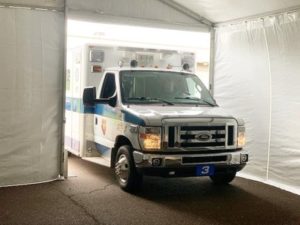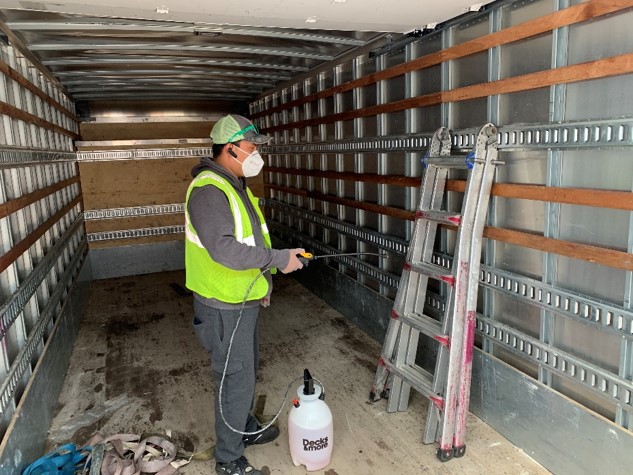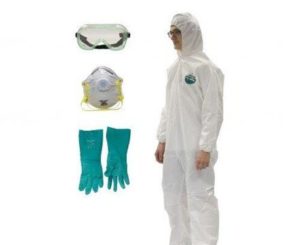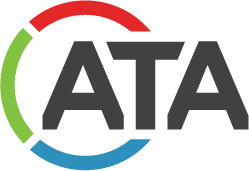Brought to you by the Tent Rental Division

The COVID-19 pandemic has created concerns with how to successfully disinfect and sterilize tent fabrics, framework, fittings, webs, ratchets, poles and anchoring devices including ballasts—basically any item or piece of equipment that may be on the job site. The Tent Rental Division (TRD) of Industrial Fabrics Association International (IFAI) worked with cleaning experts, vinyl manufacturers and others to determine the best practices for disinfecting material and equipment before putting it back into your rental fleet. Our goal is the safety and comfort of employees and customers using your tent products for future events.
As stated by the New England Complex Systems Institute (April 2020), COVID-19 (coronavirus) is mainly transmitted via aerosols and droplets that exist on surfaces, equipment, fabric, hair dust and other particles for days. The disease is spread when people touch contaminated surfaces and then touch their face. Regular cleaning and disinfecting of surfaces that are frequent touch points help prevent the spread of this disease.
There are many answers floating out there as to how to properly destroy the virus. At the top of the list, and the only 100 percent effective way, is to properly dispose of all fabric and equipment used and replace with new. However, this is not the only solution or the most realistic. Hospitals have used vinyl products like curtains for years, and these are cleaned and disinfected after use and reused again and again, so we know that bacteria and viruses can be killed with proper cleaning processes.
Let us start with the facts. Detergents and disinfectants will break down protein. The COVID-19 virus has a protein shell that protects it. This means that any tent cleaner that is on the alkaline side of the pH scale will break down that protein shell coating and spill it out of the mycoplasma that makes up this virus. It will be dead and gone once this occurs.

Tent installations for medical sites should always be treated as contaminated. These tents should be disinfected before takedown. Quaternary disinfectants are a broad-spectrum virus and bacteria killer. Most quaternary disinfectants have a human coronavirus and SARS-associated coronavirus rating listed on the label. This type of disinfectant has been accepted by the Centers for Disease Control and Prevention (CDC) and is on the recommended EPA-registered “N list” as an effective treatment of COVID-19. Quaternary ammonium chloride is one of several known disinfectants that can treat COVID-19, and it is the one we are recommending as it protects the integrity of fabric and other products, whereas a diluted bleach, for instance, could cause damage. Quaternary disinfectants can be found at janitorial supply stores and some tent cleaning supply companies. If you are having trouble locating this type of product, you may also want to look to veterinary supply or catering/food service companies, as they often sell quaternary ammonium chloride products as well.

Because you will be doing the first round of cleaning on-site, proper Personal Protective Equipment (PPE) should be available before any takedown begins. This should include waterproof/disposable gloves, face masks, goggles, protective gowns/shoe covers (if available) and plenty of soap and water to protect your employees in the cleaning process.
Best practices for treating the COVID-19 virus
- Use only a quaternary disinfectant to confidently break down the virus (and not harm the vinyl). It should be mixed at a rate listed on the label; often that is 2 ounces per gallon of water.
- If you can’t find an appropriate cleaning solution or quaternary disinfectant, bleach can be used if diluted properly. Be aware, however, that it is very corrosive to metals and will rob the plasticizers in vinyl, making it less flexible. It should be mixed 8 ounces to a gallon of water.
- Do not wet down the fabric/equipment with water before applying disinfectant. Once the disinfectant has been applied, leave on wet for at least 10 minutes.
- Spray the disinfectant onto the dry tent, components and accessories. Be sure to spray from the bottom up to prevent streaking and ensure that all surfaces are thoroughly covered.
- Please allow a dwell time (soak time) of at least 10 minutes on all flooring, vinyl and related components. This timing is very important to break down the virus.
- Once removed, it is important that the tops be washed again with soapy water to further remove contaminates. This includes the framework and related components as well. If using washing machines, ensure that the water temperature does not exceed 105°F to protect the fabric.
- When washing these items for a second time back at your warehouse, be sure your employees are again wearing the proper PPE.
- Air dry thoroughly before placing in storage or putting back into use.
- Do not forget your HVAC systems. While the disinfectants will work on the outside, you must remove the contaminates from the internal workings of the unit. This can be accomplished by running a 1,500 milliliter per hour or higher Ozone Generator in an enclosed 500- to 1,000- square-foot space for one hour before returning to inventory.
- Dispose of any masks, gloves, gowns, etc. after the cleaning process.
This pandemic is ever changing, and as more information and/or better methods become available, we will keep you up to date, as well as updating our recommendations, if necessary.
References/additional resources
- Chuck Shipp, Shipp Cleaning Inc.; www.cleanatent.com; chuck@cleananything.com
- www.cdc.gov/coronavirus/2019-ncov/prevent-getting-sick/cleaning-disinfection.html
- necsi.edu/coronavirus-guidelines-for-cleaning-and-disinfecting-to-prevent-covid-19-transmission
- www.epa.gov/pesticide-registration/list-n-disinfectants-use-against-sars-cov-2
- www.nejm.org/doi/full/10.1056/NEJMc2004973?query=featured_coronavirus
IFAI disclaims any liability for any damage or illness that may result from the use of the information contained within the Recommendation for Cleaning COVID-19-Related Tents. In no event will IFAI be liable to any party for any direct or consequential issues that may arise as a result from utilizing this information. The information contained is meant to be a guide and recommendation for the most effective way to clean a possibly infected tent but does not cover all scenarios, including human error.
 TEXTILES.ORG
TEXTILES.ORG



